File: Optical Illusions
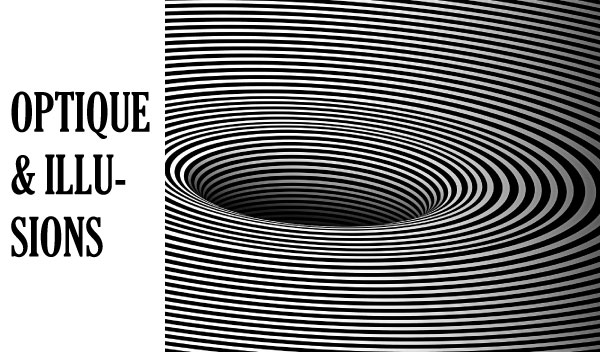
Optical illusions are always on the rise! Digitization has accelerated the cult of the image and the many formats, video, photo, GIF or virtual reality, have reinforced its emulation! Some have even exploded records of views on social networks and have had their place on television sets. Why do optical illusions fascinate us so much, and above all, how do they work? This is what we will try to determine.
The goal of optical illusions: to trick our brains. Yes but how ?
It is well known that optical illusions are created to trick our brains . But how to deceive an organ as powerful as the human brain ?
First of all, you have to know that, to deceive something, you have to cheat your habit . The human brain is capable of recording millions of data . Every experience of life, every object that we encounter is recorded in this database of our own.
What is fascinating in illusions optics is precisely their ability to deconstruct what our brain knows. This is the case of the Adelson chessboard .
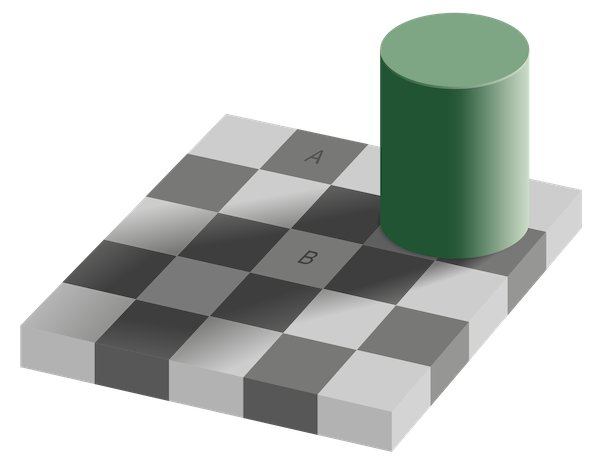
In this illusion, the brain interprets the dark region to the left of the cylinder as a shadow zone which would come from said cylinder. The different shades of green on the right side of the cylinder also mislead the brain, which immediately thinks of a point of light .
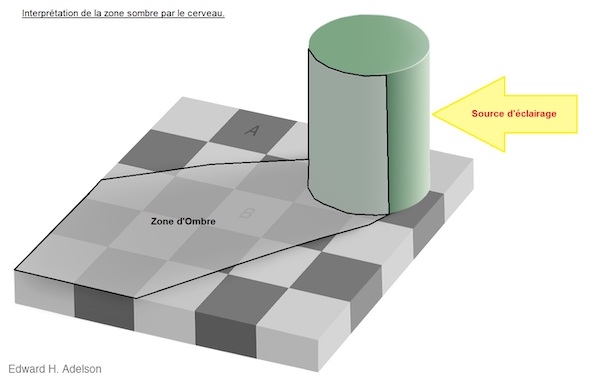
The false shadow, as well as the fact that, for our brain, a chessboard necessarily contains squares with alternating colors , misleads us. Thus, we have the impression that the two boxes are different even though they are strictly the same color.
Illusions of color
There are a multitude of optical illusions, and not all of them use the same mechanisms . Thus, the so – called color illusions can be misinterpreted or simplified, or a defect of our photoreceptors .
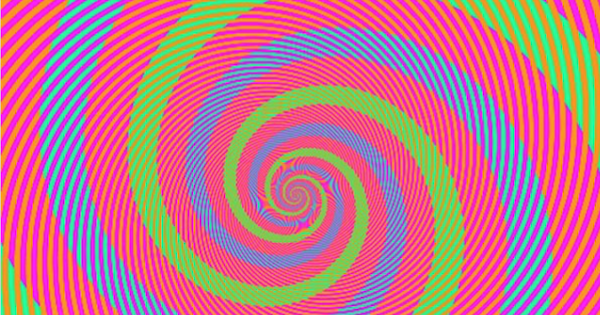 Green and blue curves? Well no, identical curves, with a different environment!
Green and blue curves? Well no, identical curves, with a different environment!
In the 15th century, Leonardo da Vinci updated the principle of retinal persistence . He indicates that " if the eye which is looking at the star quickly turns away from the opposite part, it will seem to him that this star is composed into a fiery curved line. And this happens because the eye reserves, for a certain space, the similitude of the shining thing and because this impression of the star's brightness persists longer in the pupil than did the time of its movement. "
It was not until the 19th century that Michael Faraday defined this phenomenon, which describes the fact that after observing an object, its image is formed on the retina by the 'intermediary of the optic nerve to stay there for a fraction of a second. In reality, our retina has a " certain slowness" . Indeed, a new image is formed every 1 / 12th of a second.
This is also why very fast objects, like shooting stars, appear to be just a bright, fuzzy line.
[ =]
The environment of colors also plays a major role in optical illusions. We saw it with Adelson's chessboard. Other illusions work on the same principle.
Indeed, luminance (quantity of visible light which reaches our eyes from a given surface) plays on our perception of the colour. It is in particular the change in luminance, whether progressive or on the contrary, gross, which causes this difference in perception.
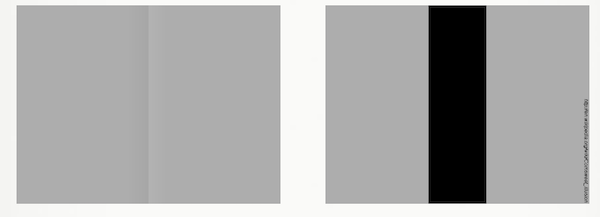 Here, the change in luminance has an impact on our way of interpreting colors (there is, on the left and on the right, only one shade of gray)
Here, the change in luminance has an impact on our way of interpreting colors (there is, on the left and on the right, only one shade of gray)
The role of geometry
Optical illusions can also play on shapes . They are then called optico-geometric illusions . This time, our retina is not involved, but our brain is deceived by different elements of our environment, causing errors in dimensions or orientation .
Müller's illusions -Lyer and Titchener allow them to be understood quickly. These illusions are made up of two elements, a test element and an inducing element.
 What is the longest line?
What is the longest line?
The test element, in multiple copies, is identical . Only, the inducing element, by its orientation, its shape or its different size, misleads the brain . Therefore, it looks like the test items are all different.
 They are all the same length!
They are all the same length!
Moreover, if we remove the inducing elements, we immediately see the similarity of the test elements.
Other factors influence optico-geometric illusions, such as perspective . An environment that plays on perspective will give the illusion that the objects placed in front are of different sizes. The perspective effect then plays its role of inducing element.
Photos that move!
The most fascinating illusions are certainly the illusions of movement , since they can bring photos and illustrations to life. In any case, to images which are supposed to remain fixed. Some almost give the impression of having hallucinations!
Illusions of movement are created thanks to the color contrasts but also thanks to the geometric shapes that compose them. They are therefore the mixture of the two types of illusions seen previously.
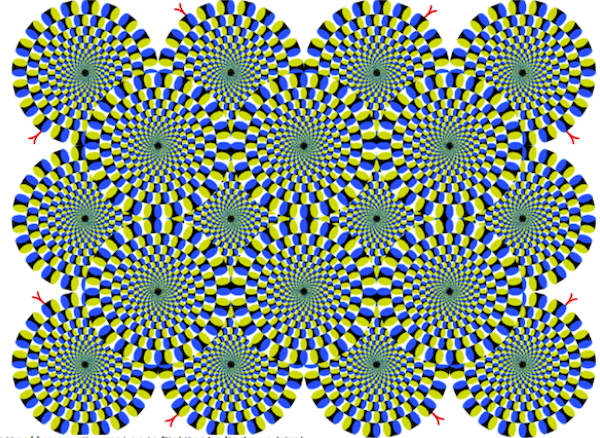 This is neither a video nor a GIF!
This is neither a video nor a GIF!
So how are these movements created?
In the image on the left, they are undulations around the center while on the image on the right, the different circles made up of ovals seem to rotate. It is the symmetry of the figures and the alternation of light and dark colors ( purple-black & white-green for the figure on the left and blue-black & white-green for the one on the right) that creates these movement effects. [ =]
The illusion of Akiyoshi Kitaoka is quite impressive. In fact, we can clearly see three rollers which turn around each other. However, this image is quite fixed. The movement is well imagined by our brain because it is deceived by the different shapes of the blue dots.
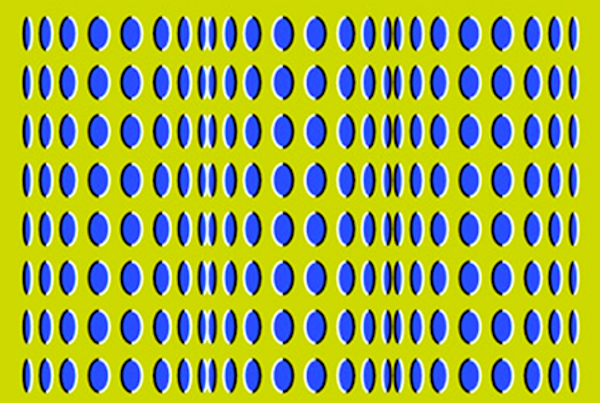 All the illusion comes from the shape and the colors!
All the illusion comes from the shape and the colors!
The fact that these shrink gives the illusion of a convex shape . The outline of the ovals, black on one side, white on the other, are all elements that induce an effect of movement.
This effect is therefore well achieved by deceiving our brain, which associates the elements of different shapes with the image of a scroll, an element that it knows and has already assimilated.
To go further on optical illusions
Optical illusions are more than entertaining pictures. They allow us to learn more about the characteristics of our eye and our brain. They also allow us to learn about how our experience sometimes influences what we can see.
To learn more about light and optical illusions , do do not hesitate to discover this episode of "C'est Pas Sorcier" devoted to this subject. It traces in particular the work carried out by the artists exhibiting during the Lyon Festival of Lights. You will discover the movement games and deceptive visual effects that create awe-inspiring illusions in the heart of the city.
[Embed] https://www.youtube.com/watch? v = P-VTfLDiMWM [/ embed]
Sources: guide-vue.fr , t pe-les-illusions-d-optique.webnode.fr


